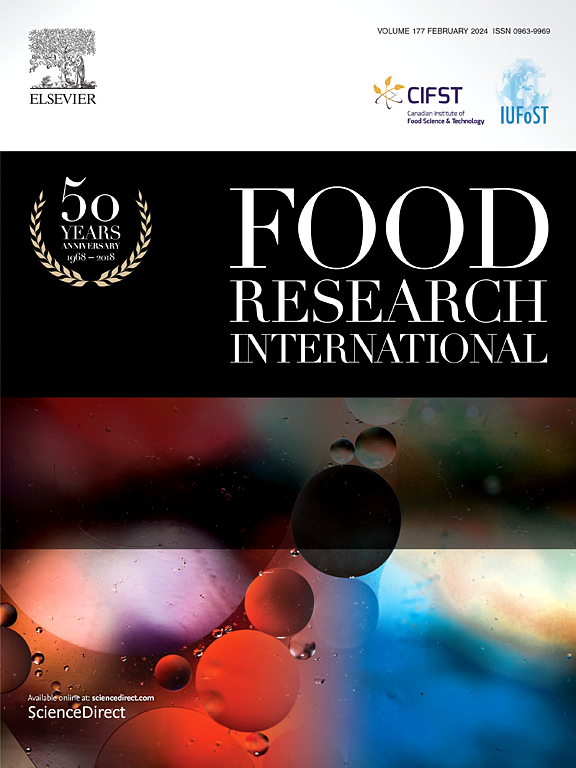Comprehensive characterization of cold plasma/nanoparticles-functionalized gelatin active film and its application in tilapia fillets
IF 7
1区 农林科学
Q1 FOOD SCIENCE & TECHNOLOGY
引用次数: 0
Abstract
With the increasing demand of consumers for food preservation materials, the development of high-performance active packaging films has become a research hotspot. This study constructed a novel chondroitin sulfate-zein nanoparticles system co-encapsulating curcumin and resveratrol (ZCRC NPs) for gelatin-based active packaging, modified by atmospheric cold plasma (ACP) to achieve multifunctional enhancement. The ACP-treated composite film exhibited significantly improved in physical properties, with opacity increasing to 1.15 ± 0.16, while mechanical strength and elongation at break improved by 168 % (from 0.025 ± 0.001 MPa to 0.067 ± 0.003 MPa, P < 0.05) and 105 % (from 25.76 ± 2.46 % to 52.81 ± 3.54 %), respectively. Barrier properties were simultaneously enhanced, with oxygen permeability reduced by 50 % (from 3.61 ± 0.05 to 1.82 ± 0.03 g/m·d) and water vapor permeability decreasing from (7.45 ± 0.76) × 10−7 to (2.63 ± 0.86) × 10−7 g/m·d·Pa. The scanning electron microscopy (SEM) exhibited that ZCRC NPs were uniformly dispersed in the gelatin-based film and exhibited good compatibility with the matrix. Fourier transform infrared spectroscopy (FT-IR) and X-ray diffraction (XRD) analyses confirmed that ACP treatment enhanced NPs cross-linking in gelatin-based films by driving hydrogen bonding, hydrophobic interactions, and electrostatic forces, while also enhancing crystallinity. Moreover, differential scanning calorimetry (DSC) and thermogravimetry (TG) analysis demonstrated that the thermal stability of the composite film was significantly improved (P < 0.05). Antioxidant capacity significantly increased (P < 0.05), with DPPH inhibition (29.11 ± 1.34 % to 60.63 ± 1.05 %) and ABTS scavenging (45.25 ± 1.67 % to 76.80 ± 1.94 %), effectively delaying fish fillet deterioration. In summary, this study provides new insights into the application and preservation potential of ACP-modified NPs in active food packaging films.

冷等离子体/纳米颗粒功能化明胶活性膜的综合表征及其在罗非鱼鱼片中的应用
随着消费者对食品保鲜材料需求的不断提高,高性能活性包装膜的开发已成为研究热点。本研究构建了一种新型的硫酸软骨素-玉米蛋白纳米颗粒共包封姜黄素和白藜芦醇(ZCRC NPs)用于明胶活性包装的体系,并通过常压冷等离子体(ACP)修饰以实现多功能增强。经acp处理的复合膜的物理性能得到了显著改善,不透明度提高到1.15±0.16,机械强度和断裂伸长率提高了168%(从0.025±0.001 MPa提高到0.067±0.003 MPa)。0.05)和105%(从25.76±2.46%至52.81±3.54%),分别为。同时,阻隔性能也有所提高,氧渗透率降低50%(从3.61±0.05降至1.82±0.03 g/m·d),水蒸气渗透率从(7.45±0.76)× 10−7 g/m·d·Pa降至(2.63±0.86)× 10−7 g/m·d·Pa。扫描电镜(SEM)结果表明,ZCRC NPs均匀分散在明胶基薄膜中,与基体具有良好的相容性。傅里叶变换红外光谱(FT-IR)和x射线衍射(XRD)分析证实,ACP处理通过驱动氢键、疏水相互作用和静电力,增强了明胶基薄膜中的NPs交联,同时也增强了结晶度。差示扫描量热法(DSC)和热重法(TG)分析表明,复合膜的热稳定性得到了显著改善(P <;0.05)。抗氧化能力显著提高(P <;0.05),抑制DPPH(29.11±1.34% ~ 60.63±1.05%)和清除ABTS(45.25±1.67% ~ 76.80±1.94%),有效延缓鱼片变质。综上所述,本研究为acp改性NPs在活性食品包装膜中的应用和保鲜潜力提供了新的见解。
本文章由计算机程序翻译,如有差异,请以英文原文为准。
求助全文
约1分钟内获得全文
求助全文
来源期刊

Food Research International
工程技术-食品科技
CiteScore
12.50
自引率
7.40%
发文量
1183
审稿时长
79 days
期刊介绍:
Food Research International serves as a rapid dissemination platform for significant and impactful research in food science, technology, engineering, and nutrition. The journal focuses on publishing novel, high-quality, and high-impact review papers, original research papers, and letters to the editors across various disciplines in the science and technology of food. Additionally, it follows a policy of publishing special issues on topical and emergent subjects in food research or related areas. Selected, peer-reviewed papers from scientific meetings, workshops, and conferences on the science, technology, and engineering of foods are also featured in special issues.
 求助内容:
求助内容: 应助结果提醒方式:
应助结果提醒方式:


